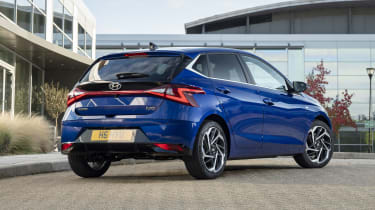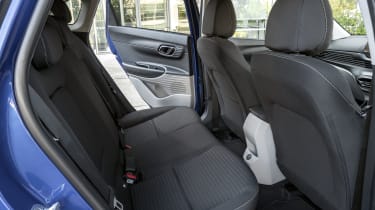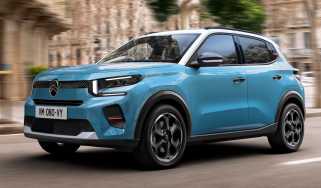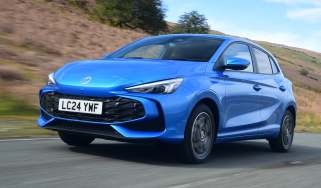2020 Hyundai i20 hatchback: prices, specs and release date
The next-generation Hyundai i20 has more tech and starts at £18,595
- New i20 is more practical and technologically advanced than ever before
- Striking styling revamp
- One engine available in UK from launch has mild-hybrid technology
The new Hyundai i20 is available in three trim levels from launch, with prices starting at £18,595, rising to £22,095 before options. All cars get an efficient mild-hybrid engine, more tech than you might expect from a supermini and very striking looks, which’ll be accentuated even more when N Line and i20 N versions join the line-up next year.
2020 Hyundai i20 hatchback UK prices and specifications
Kicking off the range is SE Connect, a new trim that’s even better equipped than the old car’s S Connect trim. You get 16-inch alloy wheels, a 10.25-inch digital instrument cluster, a rear-view camera, air con, cruise control, heated wing mirrors and leather touchpoints. Moving up to the mid-range Premium sees the price rise to £20,795 but for that you get LED headlights, heated front seats, auto wipers and a bigger screen with sat nav.
A new top-spec Ultimate trim gets two-tone paint, a Bose sound system, keyless entry and start, and wireless phone charging.
Styling
Hyundai says the i20 is the first car to carry its new design language, called ‘Sensuous Sportiness’. The new car will get a very distinctive design that aims to appeal to buyers as a stylish looking car that remains a practical supermini. With a wide grille similar to the one teased on the upcoming Hyundai Tucson and LED headlights, the front end looks very eye-catching and modern. The i20 has strong body creases, a tapered windowline and the option of a contrasting coloured roof, giving it a slight coupe look. Around the back, the tail-lights also incorporate LED lights.
Interior and Technology
Inside, the new i20 gets a significant tech update over the old car with the addition of a pair of digital screens. Both are 10.25-inches in size on Premium and Ultimate trims; one is a digital dial cluster that changes colour depending on drive mode selected and the other is an infotainment touchscreen with Apple CarPlay and Android Auto.
Hyundai has also added connected features integrated with its Bluelink app, including maintenance info, the car’s location and remote locking.
There are unconventional horizontal blades across the width of the dashboard, and Hyundai has sculpted the door cards to meet the dashboard. It looks like it’s one big swoop around the driver and front passenger, similar to the flagship Hyundai Santa Fe SUV. Three interior trim levels are available, and the i20 also gets LED ambient lighting for the first time.
Safety
There’s plenty of technology to keep you entertained but the i20 also features the longest list of standard safety kit in the supermini sector. All cars get Hyundai’s SmartSense package, which comprises intelligent speed-limit assistance, lane-keeping assist, forward collision alert and automatic high-beam functionality. Premium adds lane-follow assist, and Ultimate brings blind-spot monitoring and cyclist detection.
Engines, fuel economy and performance
Just one engine will be available from launch in the UK: a 99bhp 1.0-litre turbocharged petrol engine with a 48-volt mild-hybrid system. When fitted with the standard six-speed manual gearbox, the new i20 takes 10.4 seconds to get from 0-62mph, while picking the seven-speed automatic increases this by a second. When driving, the gearbox can decouple the engine from the transmission as you take your foot off the accelerator, which is said to increase fuel efficiency by 3-4% on its own.
The i20 is also lighter than before, which should further improve its eco credentials. You should notice a difference if you’re coming from the old i20, because the new model manages up to 55.4mpg, compared to around 48mpg from the old car. That compares well to its main rivals.
Practicality
The 2020 Hyundai i20 is longer and wider than the car it replaces, and there’s a bigger distance between the front and rear wheels too. This will improve space for rear-seat passengers, and headroom should be generous. At 352 litres, the boot is 25 litres larger and is a generous size for a car in its class. It beats the Nissan Micra and Skoda Fabia, matches the SEAT Ibiza and is barely smaller than the boot in the Renault Clio.
What does it mean for car buyers?
Cars are getting more expensive across the board, and it may come as a shock that the new car starts at around £4,000 more than its predecessor. But there’s no real entry-level trim any more; the SE Connect is quite close to the Ford Fiesta Titanium in terms of price and equipment, plus there’s plenty of tech. The car will be cheaper to run than before too. Hyundai also expects better residual values than the previous i20, so a PCP finance deal might not be too much more expensive.
Read our guide to the best used small cars, or visit our list of the best cars for £15,000.
Recommended

SEAT releases new Black Edition models with sportier styling
Most Popular

Omoda E5 targets rivals: now with zero deposit and APR

Ford Puma Gen-E driven: Electric charmer or too little, too late?
Tips & advice

Car dashboard warning lights: what does each symbol mean?

Electric car charging stations: public networks, charger types, apps and maps
















